By Kristen Uppercue
The West Virginia National Guard is charged with providing organized, trained and equipped units to protect life and preserve public safety in the Mountain State. Since the onset of the coronavirus pandemic, more than 700 Guard members have been activated to conduct diverse missions ranging from testing and sanitizing to reimagining personal protective equipment.
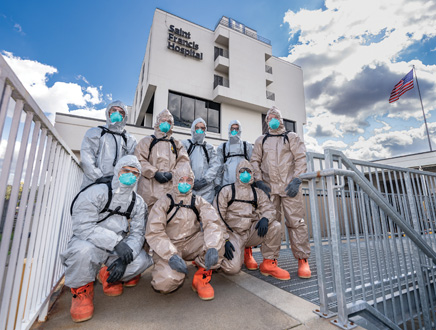
When Governor Jim Justice appointed Major General James Hoyer to West Virginia’s coronavirus task force, he gave him a twofold mission: find creative solutions to the state’s current problems that can also be parlayed into opportunities for the future.
The pandemic exasperated many of the challenges West Virginia was facing long before it began, including health care and broadband deficits. In March, the West Virginia National Guard (WVNG) began implementing several new initiatives—including creating N95-equivalent masks, 3D printing supplies and finding innovative ways to clean and sanitize first responder vehicles and long-term care facilities—in an effort to help stabilize the number of positive coronavirus cases. These efforts also play a role in the governor’s commission to help the state become more self-sufficient in filling the gaps broadened by COVID-19.
“It’s been a long, hard effort,” says Hoyer.
Responding to the pandemic has been a statewide effort. The Guard continues to work closely with local health departments, county emergency managers, higher education institutions and the West Virginia Department of Health and Human Resources (DHHR) to implement these initiatives.
As of September 9, the WVNG had completed 2,007 missions across the state, which include 220 sanitization missions in long-term care facilities and disinfecting more than 600 public transport and emergency response vehicles as well as conducting COVID-19 tests for more than 47,500 individuals.
“The concept we are using is to try to biopsy the community and see where the problems are,” says Hoyer. “I think the biggest benefit to West Virginia is for us to continue pulling all the Guard’s talent together and pushing it out to respond.”
Leading the Nation
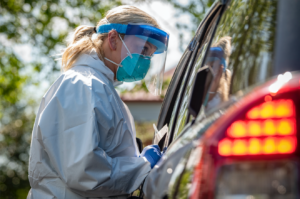
Thanks to the Guard’s efforts, West Virginia was the first state in the nation to launch coronavirus mobile testing labs, each of which are equipped to provide faster results to the COVID-19 test in hotspot areas. The labs, which were designed by Captain Samantha Fabian, can run more than 30 test samples in eight hours, taking anywhere between five to 13 minutes per test.
The testing labs are primarily stationed in Charleston and Morgantown, with the Charleston lab responsible for rapid testing in central and southern parts of the state and the Morgantown lab for the northern region and both panhandles. The DHHR alerts the Guard when rapid testing is needed, and a lab is deployed to the location within 45 minutes of being notified.
“We were the first military organization in the U.S. Department of Defense to stand up a rapid test capability,” says Hoyer. “That has been a significant benefit to the state.”
Overcoming a Shortage
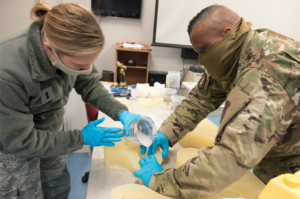
One of the biggest challenges Americans faced at the onset of the pandemic was finding approved personal protective equipment (PPE). The WVNG provided supplies to two correctional centers in the state—Lakin Correctional Center in Mason County and Denmar Correctional Center in Pocahontas County—to task incarcerated people residing there with making reusable masks and gowns. As of June, the Guard, working alongside private organizations and prison industries, helped produce 99,000 masks and 5,000 isolation gowns to build a 180-day stockpile in preparation of a potential COVID-19 surge.
“The commissioner at one of the institutions called me and said inmates were coming up to the correctional staff and saying it was the first time in their lives anybody had thanked them for something or that they had been told they had value,” says Hoyer. “If we can start making gowns and distributing them inside the state, it reduces the cost to our health care providers in West Virginia and puts some additional money back into the prison system. More importantly, it can rehabilitate somebody. That is taking a bad situation and turning it into a long-term opportunity.”
In another effort to provide PPE to both civilians and medical personnel in West Virginia, the Guard has collaborated with higher education institutions and businesses in the state to design an N95-equivalent, 3D printed mask, coined the West Virginia Mask. N95 masks are respirators recommended by the Centers for Disease Control and Prevention (CDC) for health care workers to filter out large and small particles and block out 95% of small particles. The CDC does not recommend civilians wear these masks in order to save the resources for health care workers battling the coronavirus on the front lines.
“In the Guard, one of our principles is to manage challenges and turn them into opportunities,” says Hoyer. “If we can make N95-equivalent masks we can sell to health care providers long-term at a reasonable cost and we no longer have to rely on supply chains outside the U.S., not only did we solve a problem, we created an opportunity going forward.”
Working with the West Virginia University Center for Inhalation Toxicology, the Guard is currently creating prototypes of the West Virginia Mask for approval by the National Institute for Occupational Safety and Health. Once approval is received, the Guard will begin mass producing the masks. The West Virginia Mask also features an available area for an oxygen or water tube, which will allow health care workers to provide oxygen to patients in a safe way or allow them to safely drink water without removing their mask.
“Say our folks on the front lines are out testing people in the community,” says Hoyer. “If they are wearing one of our masks, they have the ability to leave the mask on and hydrate while continuing to work. This will allow us to be more productive and take care of our people.”
Constructing Creative Solutions
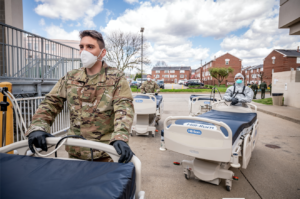
Early in the pandemic, state and national leadership thought there would be a significant shortage of N95 masks, and an emergency use authorization approval was issued to decontaminate used masks.
“We built a vapor chamber in the back of a trailer and equipped an aerosolized hydrogen peroxide system to decontaminate masks,” says Hoyer.
Guard members quickly realized this technology, which is typically used to decontaminate medical devices inside hospitals, was capable of much more and began using it to decontaminate masks and gowns in situations where PPE materials were low. To date, it has been used to sanitize more than 11,200 N95 masks. It has also been utilized to protect health care workers outside the hospital who are responding to crisis situations. The Guard equipped the aerosolized hydrogen peroxide system—which uses a non-toxic, non-residue hydrogen peroxide solution that looks like a dry fog—to clean HVAC systems in long-term care facilities and buildings where COVID-19 contamination has taken place as well as ambulances, police cars, fire trucks and other first-responder vehicles. According to Hoyer, it has been used to sanitize more than 600 emergency service vehicles.
Looking Forward
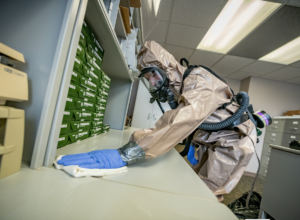
From creating internet hotspots for telemedicine and virtual learning to converting phone lines at Saint Francis Hospital in case of an emergency to working alongside the governor’s office to support the grant process, the Guard has taken on many roles to serve West Virginia throughout the pandemic.
“I guess you could call us the Swiss Army knife for the state of West Virginia,” says Hoyer.
For now, Hoyer is looking forward. The Guard will continue to provide support and is already working on a COVID-19 vaccine distribution plan for West Virginia.
“I think our objective right now is to be able to manage this through a vaccine, which I hope comes sooner rather than later, but history shows that vaccines don’t come quickly. When they do, it typically takes a lot of time and effort to get them administered,” he says. “I think we just have to plan to hold steady. We are prepared for what we need to do.”



